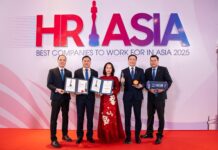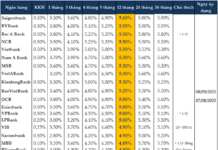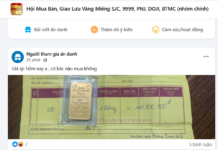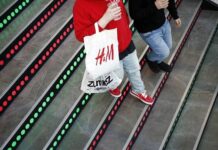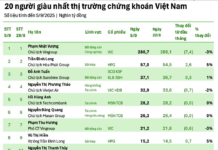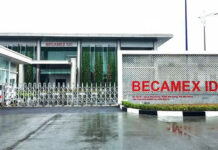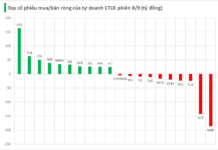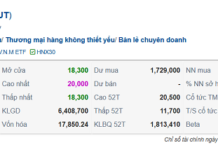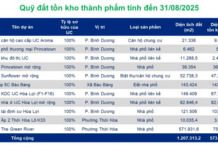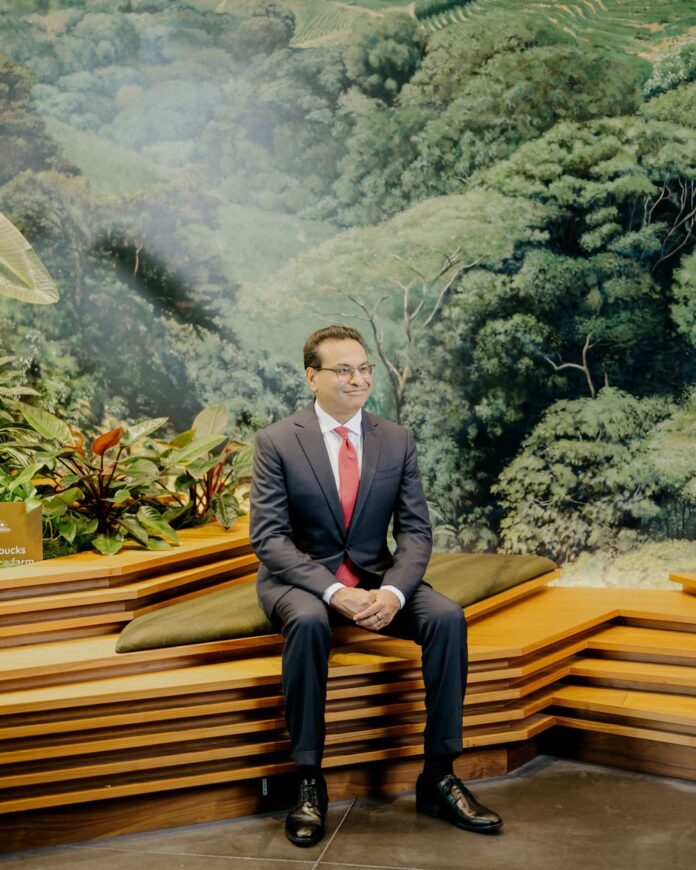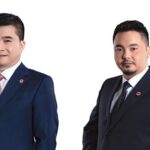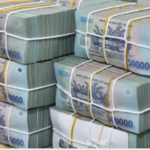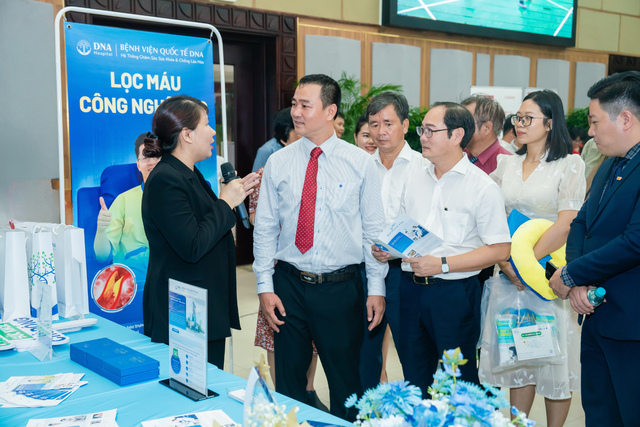At a meeting on July 31 at Starbucks headquarters, CEO Laxman Narasimhan took to the stage, donning a jacket emblazoned with the chain’s logo. He addressed the employees below about his excitement, as well as signs of change.
“Clearly, we are facing very significant challenges. But they are not insurmountable,” he told employees at the July 31 meeting in Seattle. At the company’s earnings call the day before, he had asked investors for patience.
However, Narasimhan’s days leading the coffee giant were numbered, as the company’s board had found his replacement.
Narasimhan’s departure from Starbucks continues a period of turmoil at the world’s largest coffee chain. This year, Starbucks has faced confrontations from two large shareholders, public criticism from longtime former CEO Howard Schultz, and slowing sales growth. This week, the company appointed its third CEO in less than two and a half years.
By hiring Brian Niccol, a veteran of the restaurant industry, as its new leader, the board said on Tuesday that it wanted to bring stability to the company.
Niccol, 50, is the man who helped turn Chipotle into a force in the industry after the company stumbled over food safety issues. He now says he is energized by the opportunity to drive growth at Starbucks and improve things for customers and employees.
Behind the scenes, Niccol’s appointment was the culmination of months of anxiety within Starbucks about its direction and leadership.
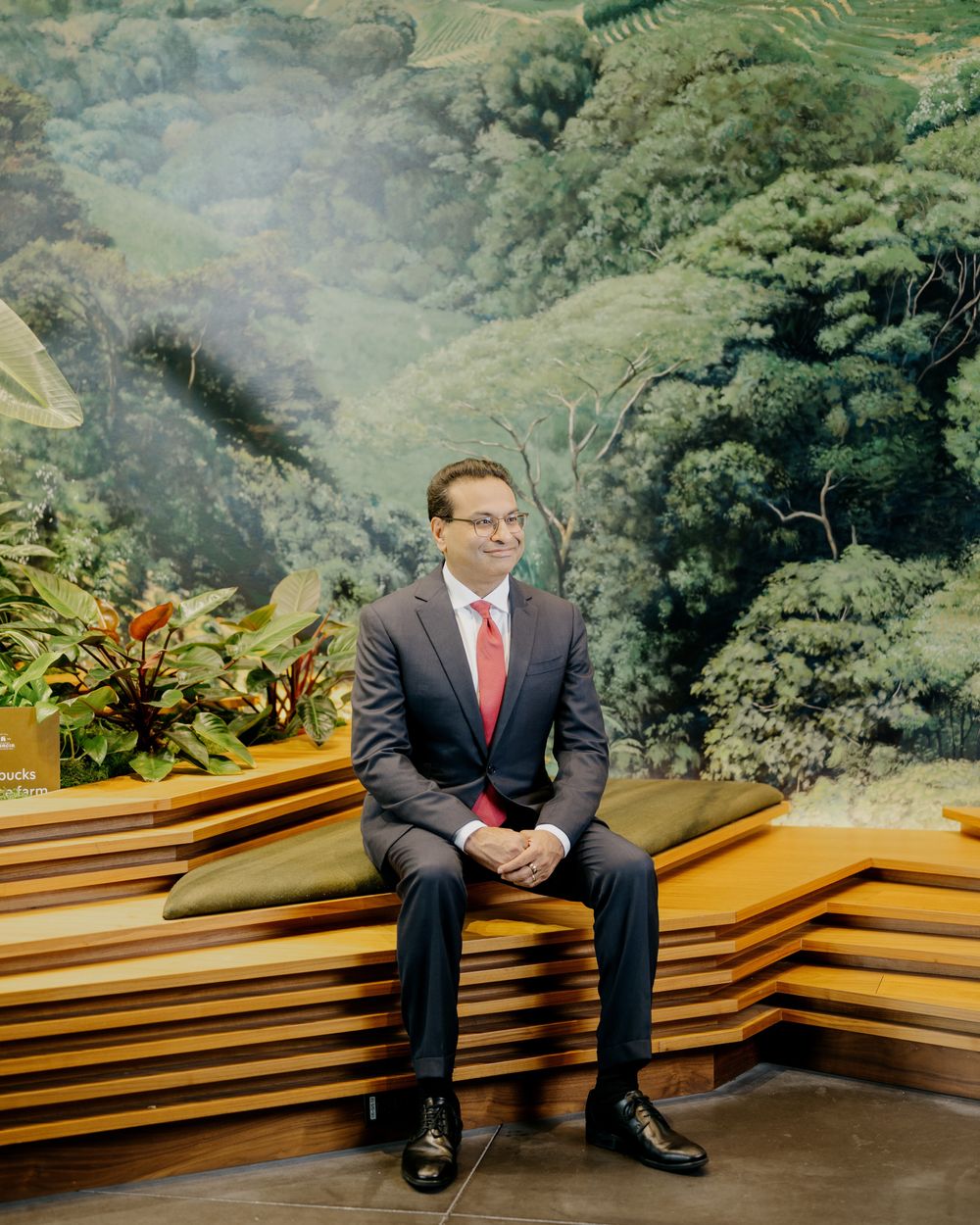
Narasimhan lost his CEO position after just 16 months.
Investors were increasingly skeptical about the company’s ability to achieve the lofty financial goals set before Narasimhan joined the company.
Some employees said they had read news stories about the demands of large shareholders, with questions and concerns. And the company’s board had quietly discussed finding a viable replacement while he remained in charge.
Starbucks board chair Mellody Hobson said in an interview that the board had been thinking about the company’s trajectory for some time.
The board had no particular connection to Niccol but zeroed in on him as the best possible replacement for Narasimhan. The board set its sights on trying to lure him directly to Starbucks, rather than using a recruiter.
Hobson said she asked a trusted associate to call Niccol, keeping the discussions within a tight circle. She said she was delighted that Niccol took the call, and she later flew 25 hours from Europe to California to meet him in person and offer him the job.
Hobson said Starbucks’ board managed the entire recruitment process, with only a few outside advisors to complete it. At the end of the process, the board reached out to Schultz. He wholeheartedly supported the plan.
To attract Niccol away from Chipotle, Starbucks offered him the roles of both CEO and board chair. Niccol had held both positions at Chipotle.
“We had the opportunity to get Brian Niccol,” Hobson said. “In the industry, he is probably the most successful CEO right now.”
Narasimhan, 57, has been in touch with one of the company’s large shareholders, Elliott Investment Management, in recent days, according to people familiar with the discussions. He was informed of Starbucks’ decision on Sunday.
Narasimhan did not respond to a request for comment.
AMBITION
A few weeks after signing on as Starbucks’ “CEO-elect” in September 2022, Narasimhan was trained to become a barista, learning to make lattes and working in stores, as part of a six-month training period.
Schultz, concerned that Starbucks’ management had become too removed from day-to-day operations and the chain’s brand, remained CEO while Narasimhan absorbed suggestions from workers.
Schultz was in his third stint as CEO of Starbucks at the time. He had rejoined the company in early 2022 to quell unrest among baristas seeking to unionize and to prepare a successor. Schultz said this would be the last time he ran the company he built, and he did not plan to keep an office at headquarters.
When Starbucks’ board targeted Narasimhan in the summer of 2022, he had little experience running a global restaurant operation. As CEO of Reckitt Benckiser, he had steered the British maker of Lysol and infant formula through the Covid-19 pandemic.
And although Narasimhan had run food businesses as global chief commercial officer at PepsiCo, Starbucks’ board planned to bring him into the company under Schultz’s watch.
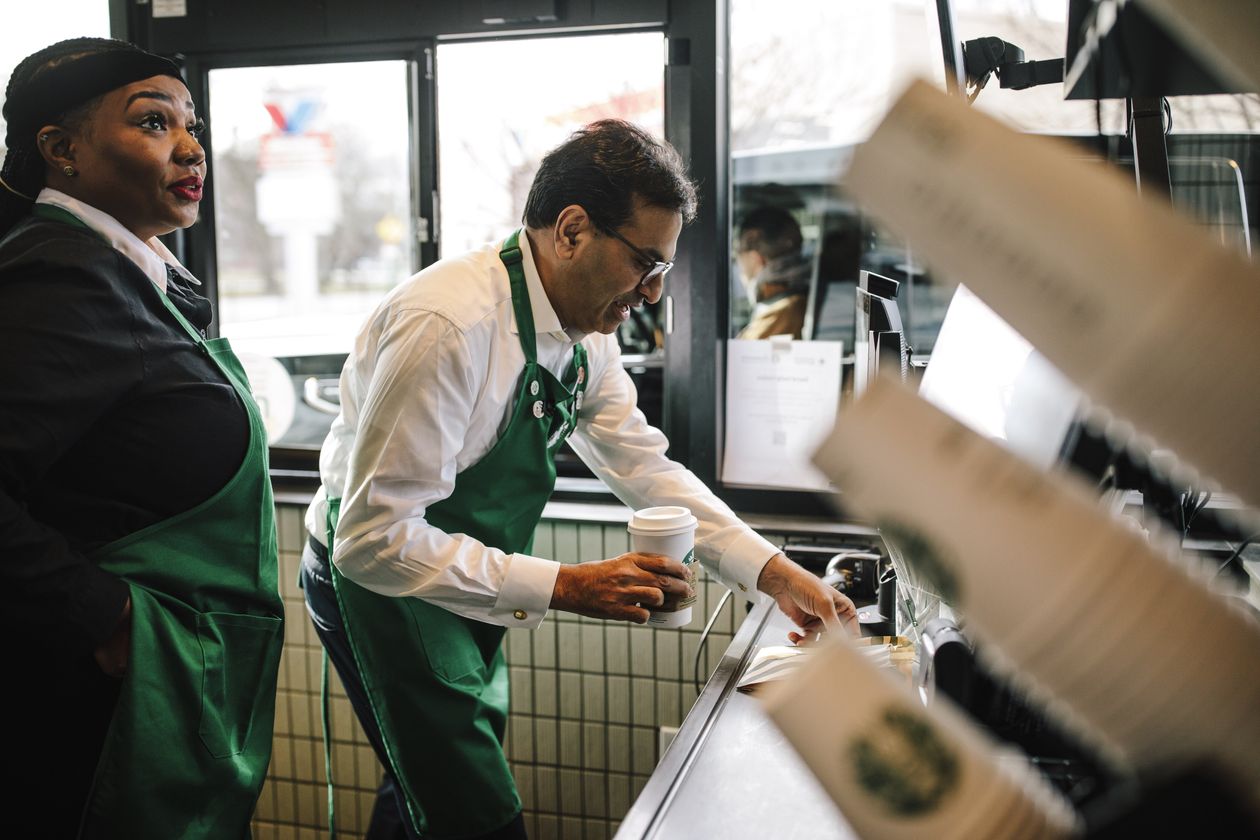
Schultz handed over the reins to Narasimhan in March 2023, about 10 days earlier than expected. “As I pass the apron to you now, know that you have my boundless trust and love,” Schultz wrote to Narasimhan in a letter.
Narasimhan also inherited an ambitious roadmap set by Schultz and other Starbucks executives, which included targets for annual revenue, same-store sales, and unit growth that were higher than previous estimates. The roadmap was expected to last until 2025.
SETBACKS
Narasimhan acted quickly to make his mark. Based on ideas gathered while working in Starbucks cafes and talking to employees, he began to simplify the company’s vast supply chain and operations, recognizing the direct link between inefficient drink preparation and long lines that frustrated customers.
At headquarters, he streamlined some of the company’s functions, eliminating roles such as global chief marketing officer and reallocating responsibilities to geographic divisions. He hired a Target executive to improve Starbucks’ supply chain and promoted leaders to oversee the North American and international businesses.
Narasimhan frequently held “Snacks With Laks” forums for people to share their thoughts.
Starbucks investors were initially optimistic: In the six months after Narasimhan joined the company, its stock rose about 8%, compared to a 15% decline in the S&P 500 stock index.
However, bigger challenges were emerging for Starbucks. The chain repeatedly raised prices to cope with inflation. Customer complaints about slow service continued to mount, with orders often highly customized through the chain’s increasingly popular mobile app.
In China, a huge market that Schultz had painstakingly cultivated for decades, Starbucks was losing market share. By mid-2023, Luckin Coffee had surpassed Starbucks to become the largest coffee chain in the country in terms of sales and units, capitalizing on speedy delivery and new flavors to recover from an accounting scandal that had sidelined the Chinese chain.
At an investor conference in November 2023, Narasimhan said the company was largely on track to meet its growth targets. He said he remained committed to running the company’s China business, contrary to the spinoff that some investors wanted.
But behind the scenes, Narasimhan was worried about the brand’s reputation. The company had become entangled in the aftermath of the Israel-Gaza conflict, drawing criticism from both sides. He issued a company message in December refuting false portrayals of Starbucks’ stance, but consumer surveys showed the damage had been done.
Starbucks’ business continued to deteriorate, and Narasimhan tried to prepare the company’s board for a difficult quarterly earnings update in late April.
The company reported that same-store sales had declined in the first three months of 2024, the first quarterly drop since the chain struggled with the pandemic in 2020, and that customer traffic in the US had suffered its biggest quarterly drop since at least 2010. The company’s active rewards program lost 1.5 million users from December 31 to March 31.
Starbucks’ troubles also caught the attention of Schultz. A few days after the earnings release, Schultz wrote on LinkedIn that Starbucks needed to refocus on the customer experience and cafe operations—what he called “the reason for the erosion of the trust in our brand.”
His post received thousands of likes and supportive reactions, with many former Starbucks employees chiming in to express their agreement. Others said they thought Schultz should keep his opinions to himself. In June, he spoke again about Starbucks during a four-hour appearance on the Acquired podcast, saying the chain was not having a great year.
“To be fair to Laxman, there were a lot of external issues that contributed to the pressure, like every other company,” Schultz said. “But the company didn’t execute in the way that I think it should have.”
PUSHBACK
Starbucks’ troubles also caught the eye of Elliott Investment Management, one of the most prominent activist investors on Wall Street. In mid-July, The Wall Street Journal reported that Elliott had built a significant stake in Starbucks and had been pushing the company for weeks to make changes.
Starbucks and Elliott have, in recent weeks, discussed a settlement agreement that would give Elliott representation on Starbucks’ board. Elliott has also pushed for a review of Starbucks’ China business.
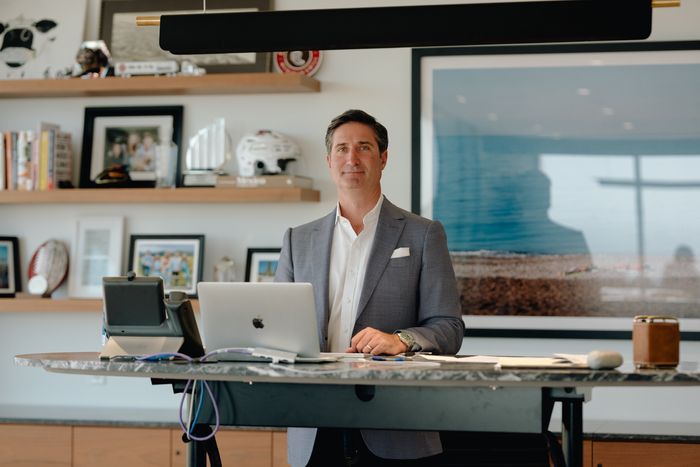
At that point, Starbucks’ board had already begun discussing the company’s direction, including replacing Narasimhan, something the shareholders were unaware of.
On July 30, Narasimhan convened a meeting with Starbucks’ quarterly investor meeting to deliver more bad news—same-store sales had fallen 2% in the latest quarter, order volume was down 6%, and profits were down more than 7%. He asked for more time: “We are making real progress,” he said at the meeting.
Narasimhan said the chain was moving to speed up service on digital orders and had introduced tapioca pearl drinks to attract curious consumers. In China, Narasimhan said Starbucks was exploring strategic partnerships for its business.
Starbucks’ stock rose after the quarterly report but remained under pressure. As of Monday’s close, the stock had lost nearly a fifth of its value since the beginning of the year, compared to a 12% gain in the S&P 500 stock index.
In Starbucks’ internal forums after the latest earnings report, Narasimhan struck an optimistic tone, saying the company was navigating a complex environment, from cautious consumers to a multi-day CrowdStrike outage that disrupted its operations.
But he said operational improvements were starting to take effect, and discussions with Elliott had been fruitful. Narasimhan thanked Starbucks employees for helping the company turn the corner and welcomed their questions.
According to WSJ
Mr. Vu Duc Tien requests leave for medical treatment, SHS appoints new CEO
After nearly a decade, Mr. Vu Duc Tien will step down from his position as CEO of Saigon – Hanoi Securities Joint Stock Company (HNX: SHS) due to his wish to take a leave for medical treatment. The new captain of SHS is Mr. Nguyen Chi Thanh.
Techcombank joins hands with Starbucks Vietnam to bring “Warm Tet from the heart” to customers
Techcombank, one of the leading commercial banks in Vietnam, has announced a comprehensive partnership with Starbucks Vietnam to provide an exclusive experience for customers from both sides. In addition to accepting membership cards and cash, customers can now make seamless payments for products and services at Starbucks Vietnam using Techcombank Visa cards, with attractive benefits.







